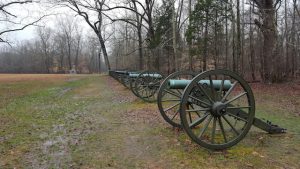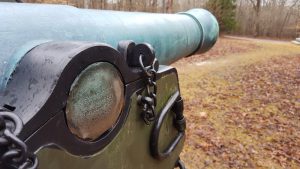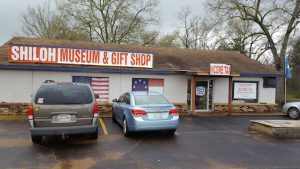We had always heard good things about the Arkansas Pen Show in Little Rock, but they were all understatements. This was our first year in attendance, and we already can’t wait to go back. There’s just something about Southern hospitality that suites us fine.
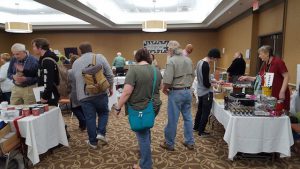
Here’s a view of the action at the 2018 Arkansas Pen Show, as seen from the wall entrance where we were stationed. Good traffic and great vendors!
Grayling, Fern and the rest of the gang who organized it did a spectacular job seeing to all of the vendor and attendee needs. Lisa Vanness and her crew hosted an incredible after-hours party. So did the Pen Addict, Brad Dowdy!
Plus, there were all of the great collectors who came to buy, sell and trade. It was a blast, and we just had fun goofing off and talking pens with everyone.
Of course, we made the trip our Spring Break run for history nerds. After three lovely days in Little Rock, I made a bucket-list trip to the Civil War battlefield of Shiloh. One of the park rangers there told me that this lesser known battlefield is actually the best preserved of all our National Park battlefields.
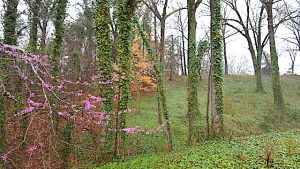
Shiloh, Tennessee, is stunningly beautiful in bloom. This is what the soldiers would have seen as they disembarked from their steamboats at Pittsburgh Landing in 1862.
The first thing to strike me about Shiloh was its absolute beauty. There is nothing like springtime in the South. Chicago is cold, grey and filthy in March. Shiloh was rainy…but it also was 72 degrees and in bloom. Words fail to describe the relief of fresh country air, green grass and flowering trees. It fills you with hope for a new season and year.
The battle was a two-day struggle in April 6 and 7, 1862. General Ulysses Grant and the Union Army were looking to cut the South in half, by taking away its only east-west railroad that had an important junction in Corinth, Mississippi. Pittsburgh Landing in Shiloh was the best place to invade. As the Union numbers grew around Shiloh, the Confederates mounted a crushing surprise attack. They nearly pushed the U.S. back into the river. But an army of fresh reinforcements arrived that night and drove the rebels back to Corinth the next day. It was the bloodiest battle of the war up until that date, with more than a combined 20,000 casualties.
The National Park Service preserved the complete battlefield, and it has made a great driving tour of it. Although it rained almost all day, I didn’t mind a little water as I walked sections I’ve read about since I was a little kid.
One of my favorite things to read about as a kid was “The Hornet’s Nest.” More than 2,000 Federal troops got trapped in a dense bit of forest and were eventually surrounded and forced to surrender. But, before they surrendered, they fought so fiercely that the rebel soldiers said the constant barrage of Minie balls coming at them sounded like angry hornets.
It was something else to actually stand in the thick of the Hornet’s Nest. To my great surprise, there are very few trees still alive from the battle. The area was forested by white oaks, and those trees only live about a hundred years. Most of the trees you see in this photo are their children and grandchildren.
Another one of the sites I couldn’t wait to see was the Bloody Pond. I was an extremely gruesome child, but I loved the idea of a pond turned red with blood. As an adult, I appreciate the informal truce of the pond during the battle. Union and Confederate troops shared the pond to clean out their wounds and get some water to quench their thirst. Yet, after such intense fighting, it didn’t take long for the pond to fill with their blood.
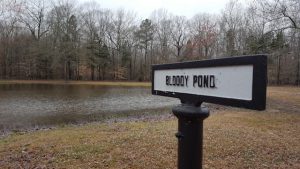
An informal truce between wounded soldiers was held at this pond as the wounded from both sides tried to clean their wounds and get some water. Yet, with more than 20,000 killed and wounded at the battle, the pond turned bright red with their combined blood.
Just south of the battlefield, on the road to Corinth, Miss., is a little museum filled with relics from the fighting. It has an impressive collection of bullets, buttons, weapons and more. I especially liked a chunk of lead that was two bullets that had collided and fused in mid-air!
However, the real treasure of the museum is its owner, Larry DeBerry. You won’t meet a friendlier soul, and it is unlikely you will meet anyone–even a park ranger–who knows more about the battle. He gives private and group tours of Shiloh, and you won’t regret a penny of it. I cannot more highly recommend taking one of his tours or just dropping in to visit his small, but memorable, museum! Check it out: Shiloh Museum & Tours.
The drive to Corinth was gorgeous! The sun came out in the mid-afternoon, and I never thought Tennessee and Mississippi could look so beautiful. There was very little left of the battlefield in Corinth, and, so, I was off to Memphis. I hit Beale Street that night for all of the Blues History.
In the morning before returning to Chicago, I got all shook up at Sun Studios.
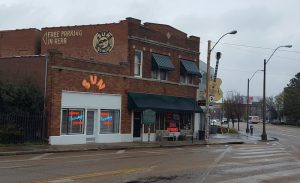
Sun Studio is where Elvis Presley, Johnny Cash, Jerry Lee Lewis, Carl Perkins, B.B. King, Muddy Waters and Howlin’ Wolf got their start.
Believe it or not, I didn’t intend to stay for a tour, but I’m glad I did. In case you aren’t up on your rock history, Sun Studio is where rock ‘n’ roll was born. Ike Turner wrote what many consider to be the first rock song, which the band he was in recorded here: “Rocket 88.” A little while later, this is where Elvis Presley, Jerry Lee Lewis, Johnny Cash, Carl Perkins and Roy Orbison all got their starts. And really, that doesn’t do justice to it. Blues stars B.B. King, Muddy Waters and Howlin’ Wolf also got their start here!
As part of the $14 tour you get to stand in the very studio where all the magic happened. Best of all, you get to hold one of the microphones Elvis sang into and sit at and touch the piano Jerry Lee Lewis used to record “Great Balls of Fire.”
All that history was a lot to pack into 48 hours, but it sure was worth it.


 Shopping Cart
Shopping Cart




